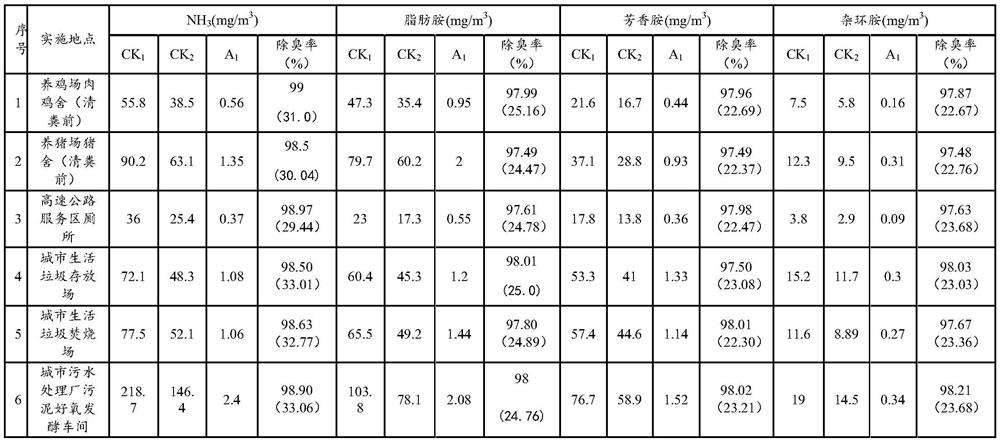Composition for removing stink related to ammonia and nitrogen compounds, preparation and application
A technology of nitrogen compounds and compositions, which is applied in the field of harmless treatment and recycling of solid waste, and can solve the problems of large spraying volume, frequent addition of agents, and poor durability
- Summary
- Abstract
- Description
- Claims
- Application Information
AI Technical Summary
Problems solved by technology
Method used
Image
Examples
Embodiment 1
[0085] A composition A for removing odor associated with ammonia and nitrogen compounds 2 , including by mass percentage: 80% of diethylene glycol (including auxiliary glycerol, glycerin accounts for 5% of its mass), 8.0% of oleic acid, 9.47% of zinc ricinoleate, 2,6-di-tert-butyl p-methyl 0.01% phenol, 0.01% sodium tetraborate, 0.5% coconut aldehyde, 2.0% sodium dodecylbenzenesulfonate, 0.01% octanol. The above-mentioned deodorant composition A 1 Raw material accounts for deodorant A 1 The mass ratio is 15%, and water accounts for 85%. All raw materials are industrial grade, and water is industrial purified water (the same below).
[0086] First, add water into the mixing tank (or reaction kettle), start the mixer, add each raw material of composition A in turn, stir at 55°C for 30 minutes to make it fully mixed, and the stirring speed is 80r / min. Cool the mixed material to below 40°C, put it into a high-shear device, and cut it at a shear rate of 20,000 r / min for 5 minut...
Embodiment 2
[0093] A composition A for removing odor associated with ammonia and nitrogen compounds 2 , including by mass percentage: propylene glycol 70% (including auxiliary glycerin, glycerin accounts for 5% of its mass), linoleic acid 15.0%, aluminum chloride 13.47%, vitamin E 0.01%, sodium benzoate 0.01%, lavender essence 1.0% %, AES 0.5%, silicone defoamer 0.01%.
[0094] The above-mentioned deodorant composition A 2 Raw material accounts for deodorant A 2 15% by mass, 85% by water.
[0095] The method of preparation and use is the same as in Example 1.
[0096] Table 2 test results show that deodorant composition A 2 The deodorant effect is better, but slightly lower than the deodorant composition A 1 , where for NH 3 The removal rate of 94.82%-96.02%, the removal rate of aliphatic amine compounds is 94.20%-96.02%, the removal rate of aromatic amine compounds is 91.98%-94.07%, and the removal rate of heterocyclic amine compounds is 94.62%-96.69%; mist spray and other quality...
Embodiment 3
[0101] A composition B for removing odor associated with ammonia and nitrogen compounds 1 , according to its mass percentage, including: citric acid 40%, glutamic acid 9.0%, FeSO 4 ·7H 2 O 0.4%, MgSO 4 ·7H 2 O 0.1%, sodium benzoate 0.01%, vitamin E 0.01%, Span-20 1.0%, coconut aldehyde 0.5%, water 48.98% (about 49%).
[0102] First add water into the mixing tank (or reaction kettle), start the mixer, and add composition B in sequence 1 Single raw material, stirred at 55°C for 30min at a stirring speed of 80r / min to make it fully mixed, cooled to below 40°C, put it into a high-shear device at a shearing speed of 20,000r / min, and sheared for 5min, that is Composition B for removing odors related to ammonia and nitrogen compounds 1 Mother liquor (referred to as deodorant composition B 1 ), put into barrels for later use. Dilute 10 times with tap water when using, and use mist spray method to remove odor.
[0103] The result shows (table 3), deodorant composition B 1 to N...
PUM
 Login to View More
Login to View More Abstract
Description
Claims
Application Information
 Login to View More
Login to View More - R&D
- Intellectual Property
- Life Sciences
- Materials
- Tech Scout
- Unparalleled Data Quality
- Higher Quality Content
- 60% Fewer Hallucinations
Browse by: Latest US Patents, China's latest patents, Technical Efficacy Thesaurus, Application Domain, Technology Topic, Popular Technical Reports.
© 2025 PatSnap. All rights reserved.Legal|Privacy policy|Modern Slavery Act Transparency Statement|Sitemap|About US| Contact US: help@patsnap.com



